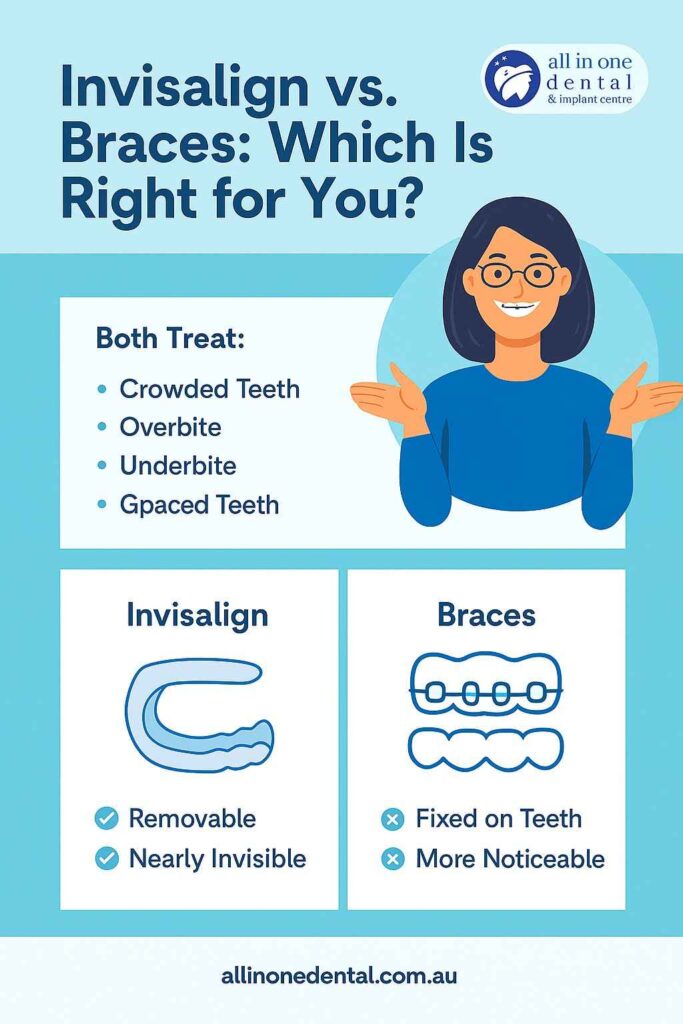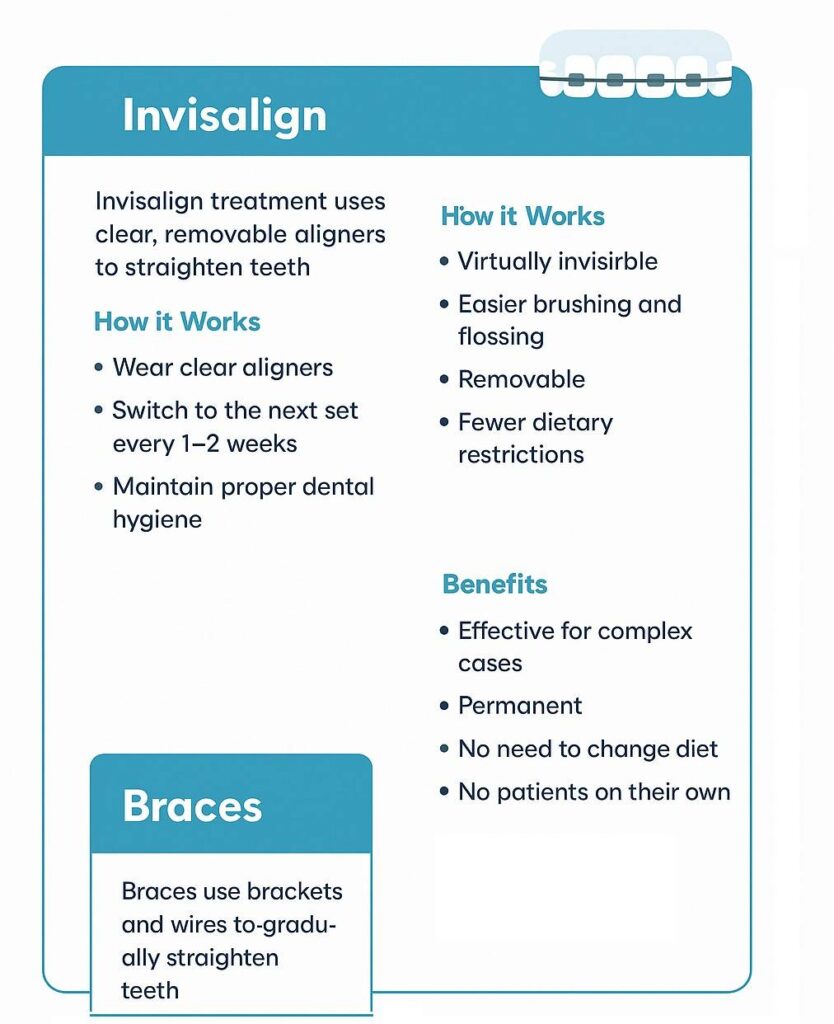How Braces Work
Braces are the traditional orthodontic treatment that use brackets and wires to move teeth gradually into place. They’ve been used for decades and are still one of the most reliable options, especially for complex dental problems. Braces are fixed to the teeth, which means you don’t have to worry about remembering to wear them, and they are effective for everything from severe crowding to major bite corrections. Ceramic braces are also available for patients who prefer a less noticeable look. The main drawbacks are that braces are visible, they make brushing and flossing more challenging, and some foods must be avoided to prevent damage.

How Invisalign Works
Invisalign is a modern alternative that uses a series of clear, removable aligners to straighten teeth. Each aligner is custom-made and replaced every one to two weeks as your teeth gradually move. The biggest advantage of Invisalign is that the aligners are virtually invisible, making them a discreet option for adults and teens. They can also be removed for eating, brushing, and flossing, which makes daily hygiene easier. Many patients find Invisalign more comfortable since there are no wires or brackets causing irritation. However, because they are removable, Invisalign requires discipline — you need to wear them 20–22 hours per day for best results. They may also not be suitable for very complex orthodontic issues, and there’s always the risk of losing or misplacing the aligners.

Lifestyle Differences
When comparing Invisalign and braces, lifestyle plays a big role. If appearance is your top concern, Invisalign is often the better choice because it is nearly invisible. If you have a busy professional life, Invisalign’s discreet look may give you more confidence in social or work settings. Braces, however, are better for patients who struggle with consistency, since they are fixed and don’t rely on patient compliance. In terms of diet, braces come with restrictions — you’ll need to avoid sticky or crunchy foods — whereas Invisalign has no dietary limits as long as you remove the aligners before eating. For oral hygiene, Invisalign is more convenient since you can brush and floss normally, while braces require additional effort with floss threaders or interdental brushes.
Invisalign vs. Braces: A Side-by-Side Comparison
Factor | Invisalign | Braces |
Appearance | Virtually invisible | Visible (metal or ceramic) |
Comfort | Smooth plastic, no wires/brackets | Brackets and wires may irritate |
Removability | Removable for eating/cleaning | Fixed, cannot be removed |
Oral Hygiene | Easy to brush and floss normally | Requires extra effort with floss threaders/interdental brushes |
Food Restrictions | None (remove to eat) | Avoid sticky, hard, crunchy foods |
Effectiveness | Best for mild to moderate cases | Effective for all case complexities |
Treatment Time | 6–18 months (on average) | 18–24 months (varies by case) |
Follow-up Visits | Every 6–8 weeks | Every 4–6 weeks |
Cost | Slightly higher for some patients | Often more affordable for complex needs |
Treatment Time
When it comes to treatment time, both Invisalign and braces vary depending on your case. Invisalign often takes between 6–18 months for mild to moderate cases, while braces usually take 18–24 months or longer for complex issues. Regular check-ups are necessary for both, but Invisalign may require fewer visits since there are no wires to adjust.
Common Questions Patients Ask
Many patients ask which option is faster. In general, Invisalign can be quicker for mild to moderate misalignment, but braces remain the most efficient choice for severe crowding or bite problems. Others wonder about comfort, and while both options involve some pressure when teeth shift, Invisalign tends to feel smoother since it doesn’t use brackets or wires. Teenagers are also great candidates for both — Invisalign Teen has special features to ensure compliance, while braces remain a tried-and-tested choice for younger patients. After treatment, retainers are required with both methods to keep your teeth in their new positions, so it’s important to plan for that as well.
Making the Right Choice
So, which option is right for you? The answer depends on your dental needs, your lifestyle, and your preferences. Invisalign is a fantastic solution for those who want a discreet, comfortable, and flexible treatment, especially for mild to moderate cases. Braces are often better for patients who need more significant corrections or prefer a lower-maintenance approach.
The best way to decide is to book a consultation. At All in One Dental in Spearwood, we’ll carefully assess your teeth, explain both options in detail, and help you choose the treatment that fits your goals, budget, and lifestyle. A straighter smile not only boosts your confidence but also improves your oral health.
